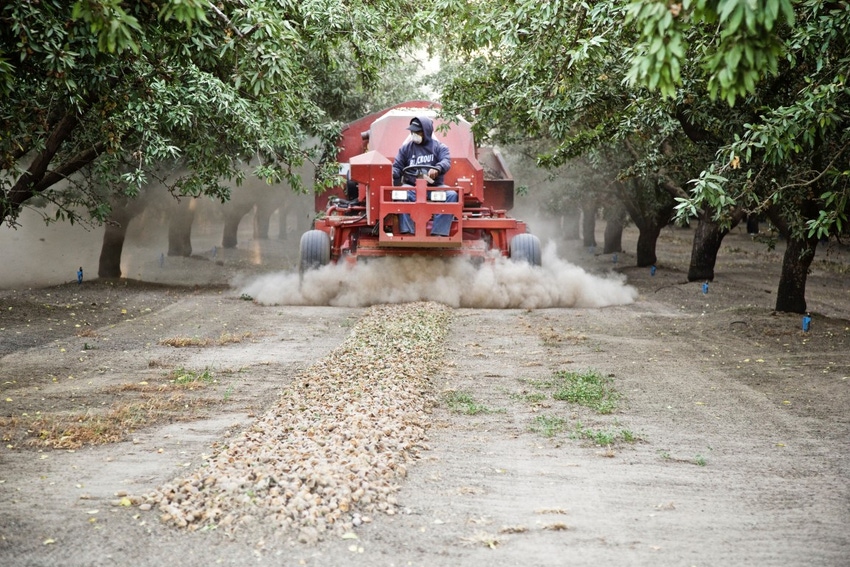
Exclusive to Western Farm Press
Almond harvest is a busy and satisfying time. Efforts of the year are brought to bear, and growers enjoy the fruits of their labor. But for neighbors and motorists, almond harvest can also bring dread, as dust from harvest settles over backyards, pools and cars, and can block drivers’ ability to see.
The dust generated by harvest activities includes significant PM10 emissions and some PM2.5 emissions - both regulated and connected to air quality issues, particularly in the San Joaquin Valley.
Almond Board research
A decade of dust research funded by Almond Board of California (ABC), partnerships with equipment manufacturers and the USDA Natural Resources Conservation Service (NRCS), has resulted in methods, resources, and incentives to help reduce the dust generated at harvest, and to keep the dust created inside the orchard and away from neighbors.
Everyone involved in the harvest of California almonds should work to reduce dust at harvest time. Growers should communicate to employees and custom harvesters their expectations for a harvest strategy that reduces dust while maintaining balance with harvest efficiency.
The strategy starts with orchard preparation prior to harvest to ensure harvest begins with a clean, level orchard floor. Under these conditions, suction fan speed can be reduced on pickup machines to dramatically reduce dust in the field without the loss of harvest efficiency.
Filling in ruts and holes where almonds can get stuck also helps reduce the need for extra sweeper passes, and allows drivers to adjust equipment heads higher.
Steps to reduce harvest dust
Maintaining a clean orchard floor increases the efficacy of specific strategies for reducing dust and PM10 at harvest developed as a result of ongoing research.
Dust control tactics include setting sweeper heads to the optimum level. Sweeper heads should be set at the manufacturer’s factory level so that wire tines are 0.125 inch off the ground. If the heads are set too low, dust from the pickup is increased substantially. Additionally, if harvesting in hilly terrain, take inclines into consideration when setting sweeper head height.
In addition, use wire tines on sweeper heads. Wire tines without rubber flaps on sweeper heads can reduce dust, particularly on softer soils.
A third dust reduction method is to reduce blower passes where possible. Three blower passes doubles the amount of dust released from the orchard at harvest compared to making a single blower pass. Adjusting blower spouts to match field conditions and/or adding an optional berm brush can reduce passes.
Next, reduce the harvester’s ground speed. A slower pickup speed of 1.5 mile per hour (mph) cuts dust emissions by 50 percent compared to a speed of 3 mph. Gauge the speed reduction to match orchard conditions. In orchards with loose soils, slower ground speed allows gravity to drop dirt, reducing the reliance on fans to do it.
Also, reduce the separator fan speed to the lowest setting possible.
And finally, blow dust into the orchard when working near field edges. When operating near roads or homes during harvest, use the trees and their canopies to naturally filter dust. Blowing rows close to the edge into the orchard allows dust to filter and settle out.
Growers who rely on custom harvesters to manage their harvest operations should discuss these strategies and the importance of protecting the reputation of the almond industry by taking all steps possible to keep visible dust to a minimum during harvest, even if it means it might take more time to harvest.
Digital resources
The Almond Board also has practical guides and videos available for growers and workers to encourage the adoption of good management practices for reducing dust at harvest. These resources are available at www.almonds.com/harvestdust.
As a result of our greater understanding about how dust is generated at almond harvest, many equipment manufacturers have made changes to sweepers and pickup machines to reduce dust emissions.
Funding incentives
NRCS has funding incentives available through the Environmental Quality Incentives Program (EQIP) for almond growers wishing to utilize clean harvest technology. NRCS this year has more than tripled reimbursements, to $37.50 per acre, for up to three years to almond growers who purchase harvest equipment shown to reduce particulate matter at harvest.
The incentive payments apply to growers who purchase new equipment or hire out the process to contractors who use approved lower-emission equipment in their orchards. Growers interested in incentive funds should visit their local NRCS office soon.
About the Author(s)
You May Also Like




